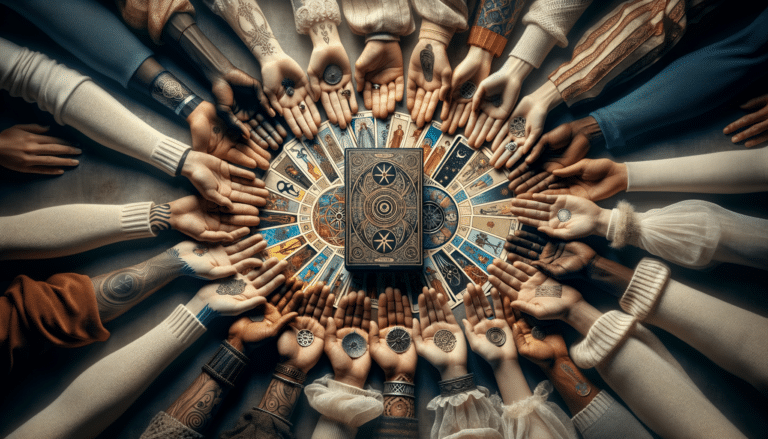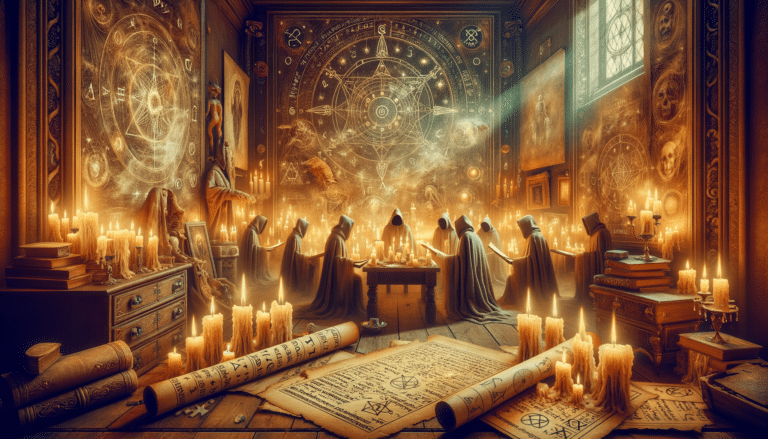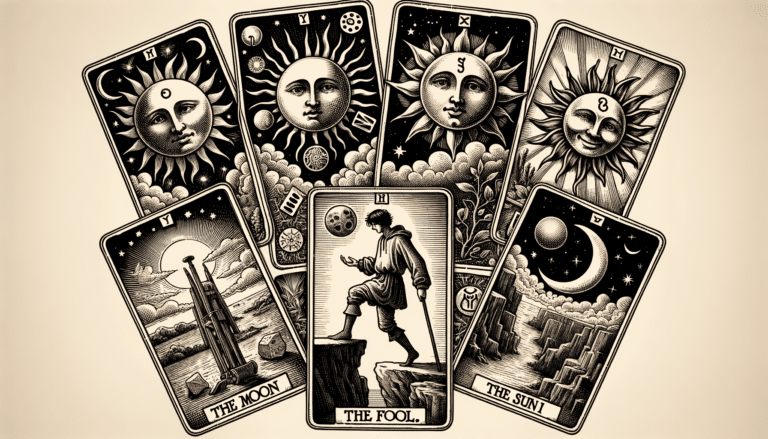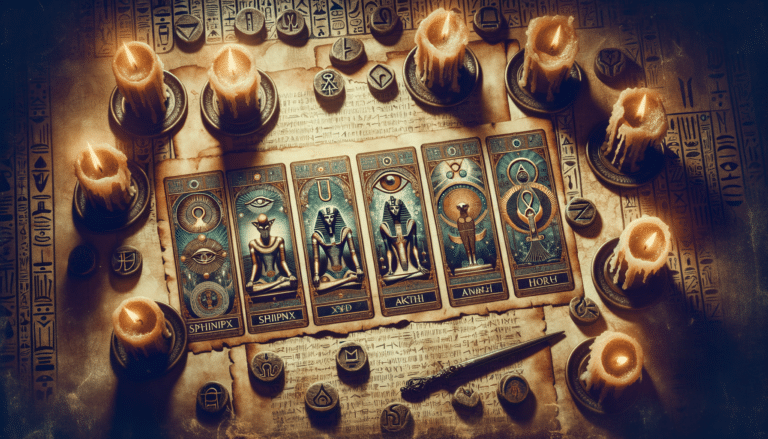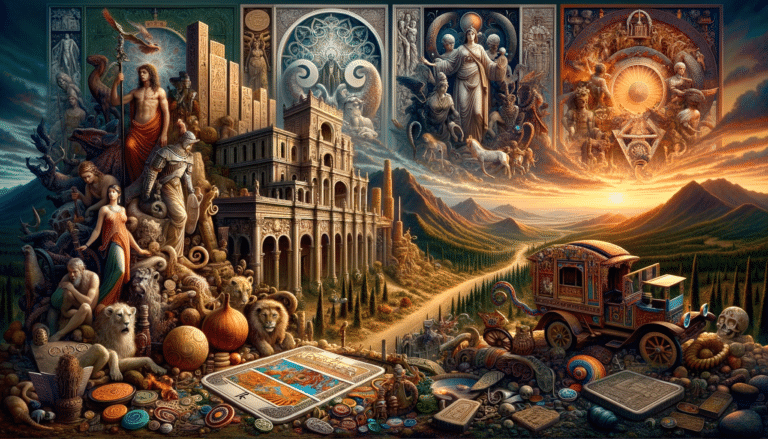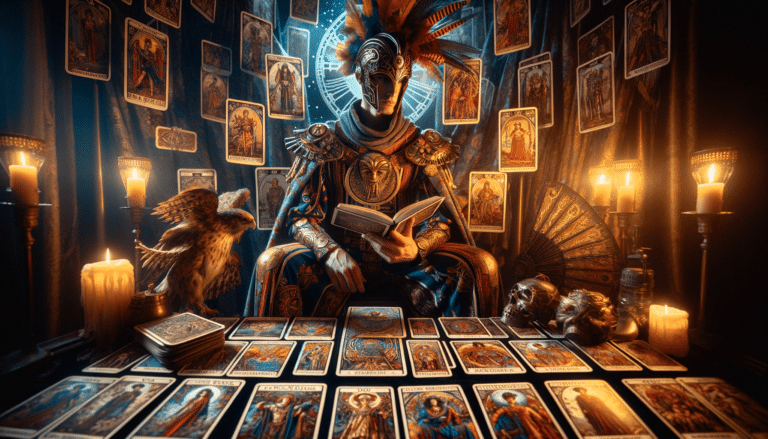Renaissance Era and Tarot Cards: Historical Insights
When you shuffle a deck of tarot cards, you’re handling a piece of the Renaissance. This era of rebirth in art, culture, and thought left an indelible mark on the evolution of tarot.
As you delve into the origins of these cards, you’ll uncover how they were shaped by the cultural climate of the time. The vivid imagery and symbolism that you see in the cards were heavily influenced by Renaissance artistic trends, reflecting the period’s fascination with humanism and the metaphysical.
You’ll also learn how advancements in printing technology during the Renaissance contributed to the spread and standardization of tarot decks.
By understanding the Renaissance’s impact on tarot, you’ll gain a deeper appreciation for the cards’ intricate designs and their transition from game pieces to tools of divination.
Key Takeaways
- Tarot cards originated as playing cards in 15th-century Europe and evolved from game pieces to tools of divination.
- The Renaissance era influenced the evolution of tarot iconography, with tarot cards reflecting the era’s fascination with humanism, art, and philosophy.
- Tarot cards integrated artistic symbolism, allegory, and philosophical ideals, becoming a reflection of the cultural climate of the Renaissance.
- Tarot cards reflected the philosophical ideals of the Renaissance, incorporating hermetic traditions, classical philosophy, esoteric symbols, and astrology. They acted as bridges between the spiritual and material realms.
Origins of Tarot Cards
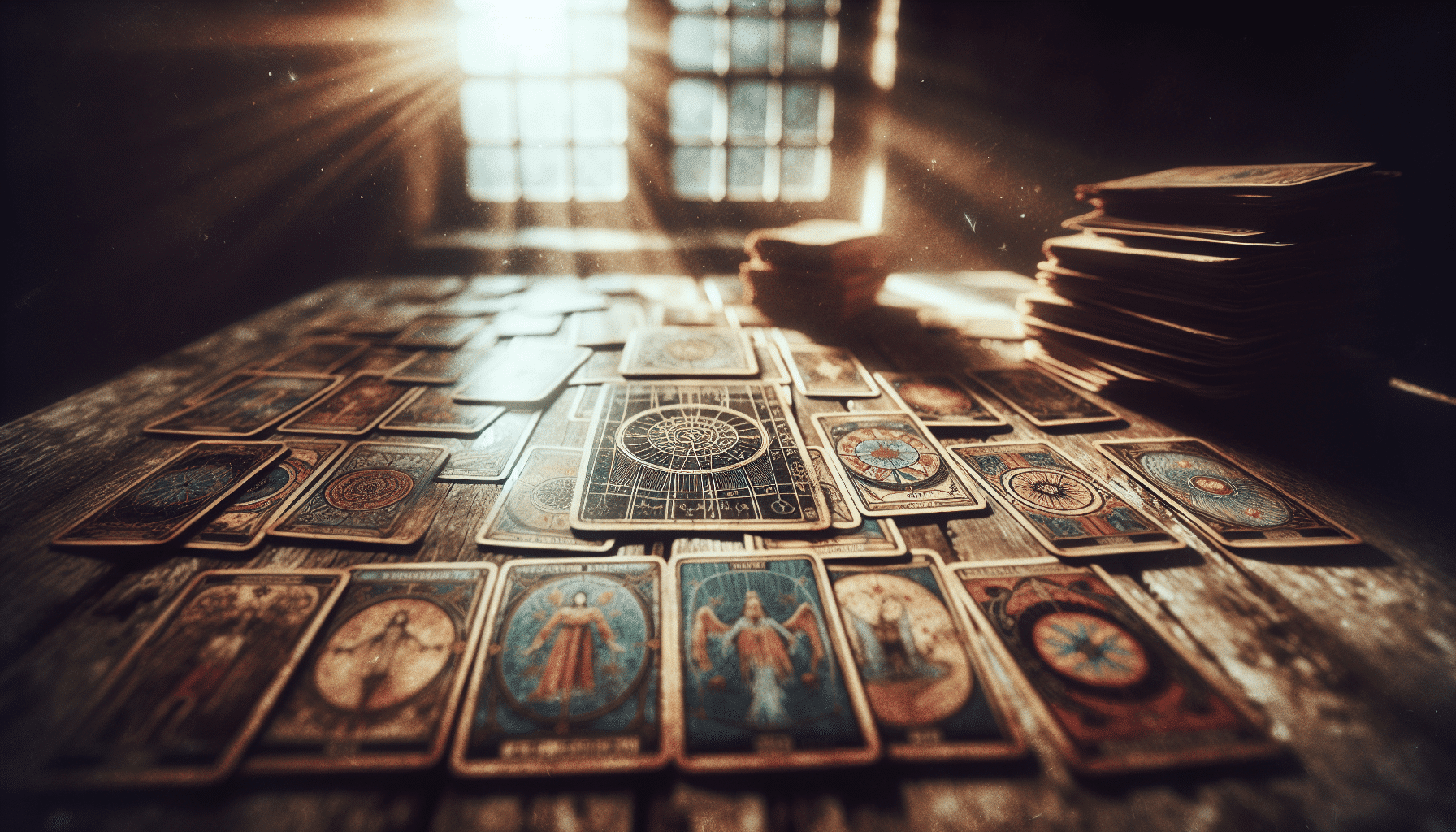
In tracing the roots of tarot cards, you’ll discover that they originated as playing cards in 15th-century Europe, primarily for the Italian nobility’s card games. These early tarot decks weren’t shrouded in mysticism; instead, they were meant for leisure, much like any card game you might enjoy today. The standard tarot deck had suits, courts, and the additional trumps, which over time evolved into the Major Arcana.
It’s essential to dispel tarot misconceptions that often cast these cards solely as tools for divination. Originally, their use had more in common with bridge or poker than with foreseeing the future. The playing card origins of tarot are a testament to the adaptability of cultural practices, as over the centuries, the cards transitioned from aristocratic pastime to mystical guide.
As you delve into tarot’s history, you’ll appreciate the complexity of its journey from renaissance parlors to modern psychic readings. The evolution from game pieces to spiritual symbols illustrates a rich tapestry of human belief and tradition.
Renaissance Cultural Climate
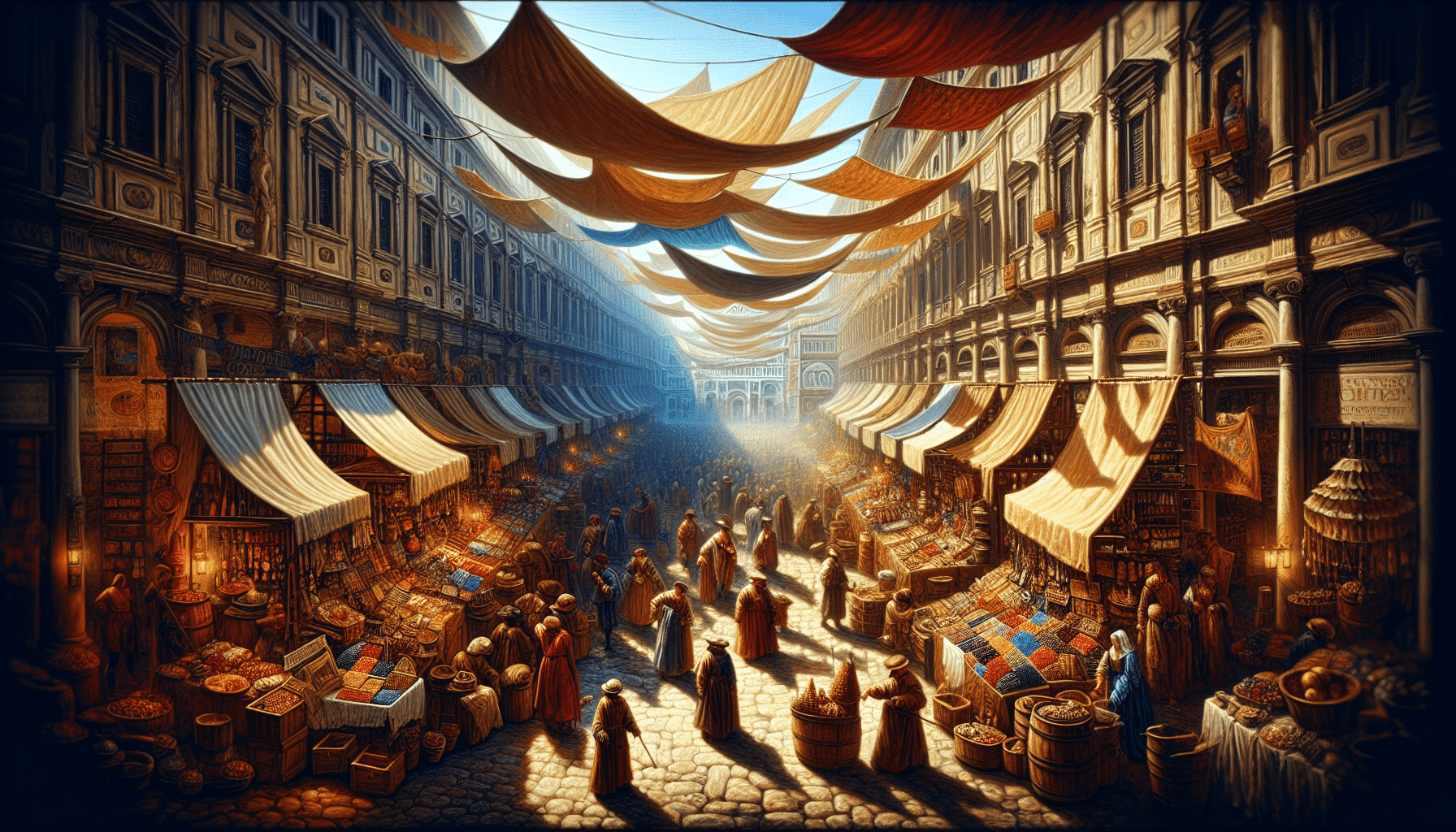
As you explore the Renaissance cultural climate, you’ll find that the era’s surge in artistic symbolism and its thirst for knowledge deeply permeated tarot iconography.
Philosophical ideals weren’t just confined to texts; they spilled over into the visual narratives of tarot cards.
This fusion of art and philosophy offered a rich soil for the evolution of the tarot’s intricate imagery.
Artistic Symbolism Expansion
You’ll often notice that the tarot imagery became richer and more complex during the Renaissance, reflecting the era’s burgeoning interest in symbolism and allegory. Artists embraced the cultural shift, infusing cards with layers of meaning that went beyond the surface.
Symbolic color usage became a subtle tool; red wasn’t just red – it suggested passion or power, while blue could imply wisdom or serenity. Divine allegory, too, snuck into the mix, turning each card into a potential reflection of heavenly stories and virtues.
As you explore these cards, you’re peering into a world where every hue, character, and object was chosen to convey a deeper message, inviting a more profound contemplation of the human experience.
Philosophical Ideals Integration
Every tarot card you encounter is a testament to the pervasive philosophical ideals that thrived during the Renaissance, shaping their evolution with profound cultural insights.
- Mystical Convergence
- The melding of hermetic traditions with classical philosophy
- Tarot imagery reflecting the union of spiritual and material realms
- Cards as bridges between the divine and the mundane
Esoteric Appropriations
- Alchemical symbols infusing cards with layers of meaning
- Kabbalistic influences evident in the structure and symbolism
- Astrological associations aligning with Renaissance humanism
The Quest for Knowledge
- The tarot’s embodiment of the era’s intellectual curiosity
- Philosophers’ impact on the interpretation of tarot symbolism
- Cards as repositories of esoteric wisdom and classical thought
You’re seeing the cards in a new light, where every image captures a fragment of the era’s rich philosophical tapestry.
Check out our Tarot Cards here…
Artistic Trends in Card Imagery
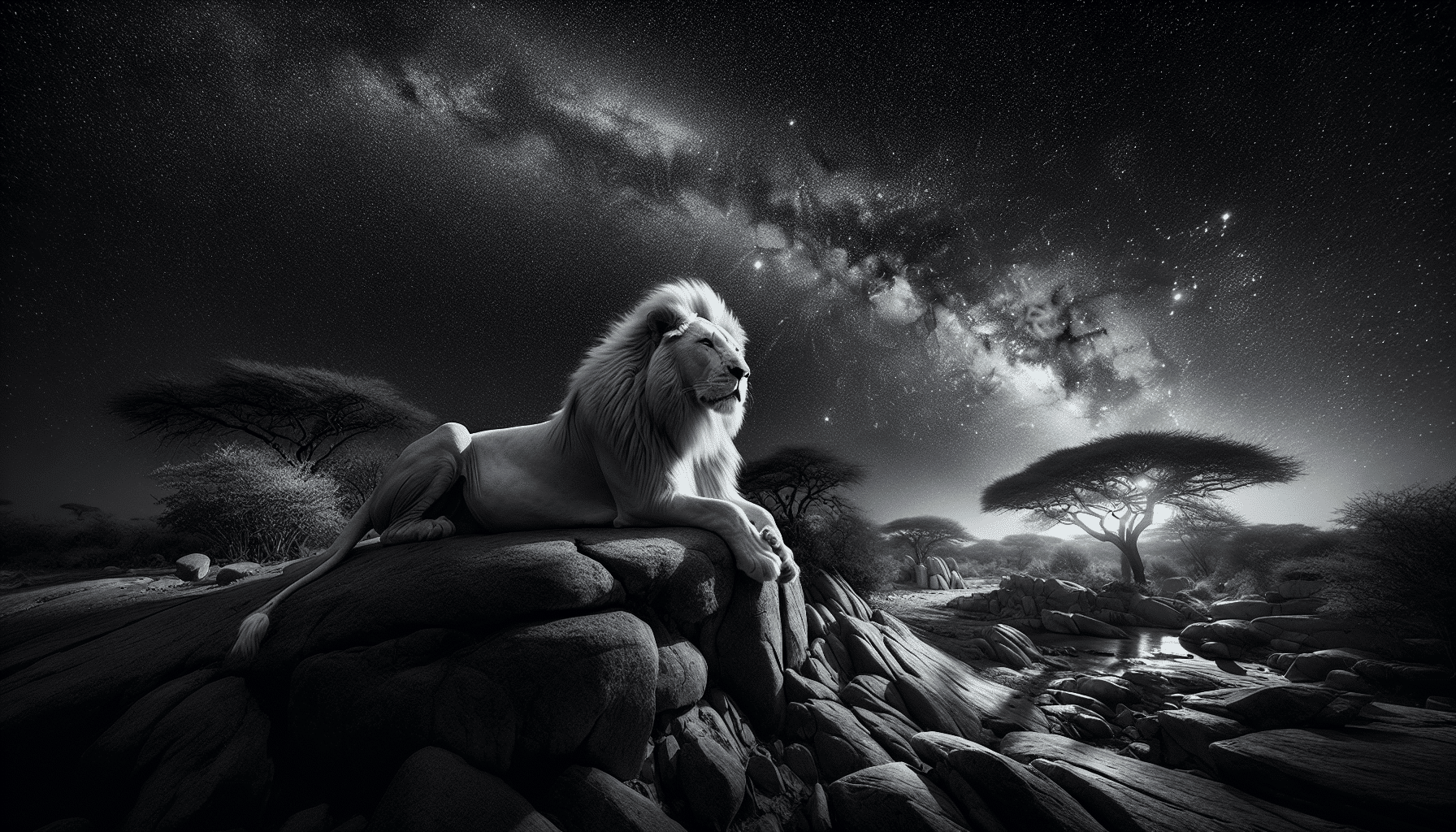
Many tarot cards display a clear Renaissance imprint through their intricate symbolism and humanistic themes. As you delve into the artwork, you’ll notice how card materials and design evolution reflect the era’s artistic trends. Initially, tarot cards were hand-painted on fine materials like ivory, but as demand grew, they transitioned to more accessible mediums such as woodcuts and eventually, paper.
The Renaissance was a time when art burgeoned with lifelike depictions of people, and tarot imagery was no exception. Artists imbued the cards with a sense of depth and perspective that was novel at the time. You see this in the way figures stand out against vibrant backgrounds, each card telling a story dense with allegorical meaning. The shift from the medieval to the Renaissance style in tarot cards is evident in the more realistic human forms, the use of light and shadow, and the incorporation of classical motifs.
As a tarot enthusiast or casual observer, you can’t help but be drawn to the cards’ rich iconography. Every time you shuffle and lay them out, you’re handling centuries of artistic tradition. It’s a tradition that continues to evolve, yet always holds a mirror to the human experience, much like the enduring masterpieces of the Renaissance period.
Learn more with these tarot books here…
Symbolism in Renaissance Era and Tarot Cards
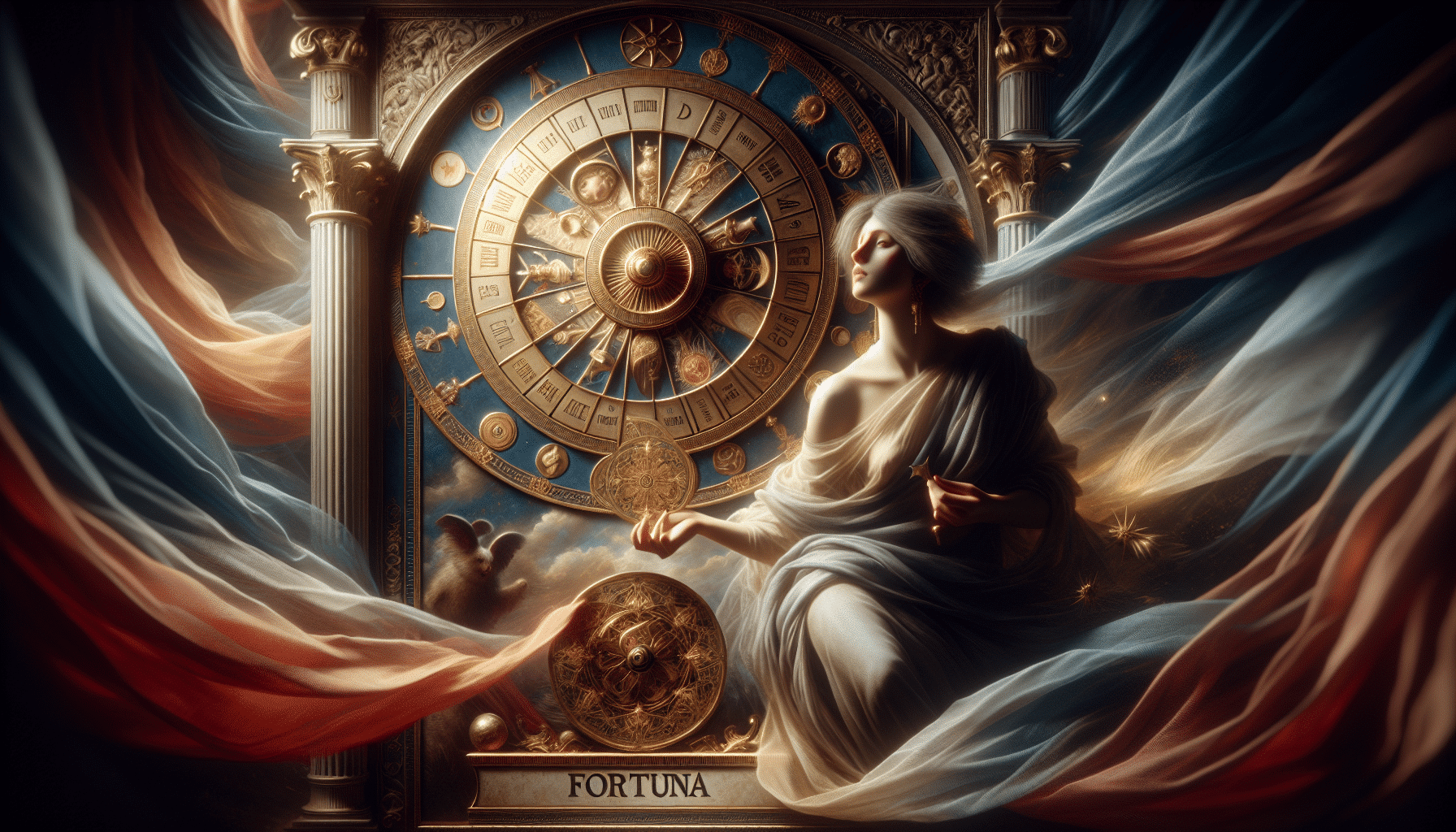
As you explore the Renaissance tarot, you’ll notice each card’s intricate iconography isn’t just artistic flair – it’s a window into the era’s mindset.
You can’t ignore the seamless integration of cultural symbols that offer a deeper understanding of the period’s values and beliefs.
These cards reflect the artistic currents of the time, making them more than just tools for divination – they’re historical narratives in miniature.
Iconography Interpretation
Delve into the layered symbolism of Renaissance tarot, where each card’s imagery reveals a tapestry of societal, spiritual, and philosophical reflections of the era. The cards hold mystical interpretations that resonate even in modern parallels, bridging centuries of esoteric thought.
The Fool
- Innocence: Embodies the spirit of adventure and beginnings.
-
Carelessness: Warns of the consequences of inattention.
The Lovers
- Choice: Represents the crossroads of crucial life decisions.
-
Duality: Reflects the harmony or conflict in relationships.
Death
- Transformation: Symbolizes the end of a cycle and the start of another.
- Renewal: Encourages embracing change as a natural progression.
Understand these symbols to grasp the profound insights the Renaissance has imprinted on tarot’s evolution.
Cultural Symbolic Integration
You’ll discover that each tarot card intricately weaves Renaissance cultural symbols into its design, reflecting the era’s complex social and spiritual fabric.
As you delve deeper, you recognize mystical archetypes within the cards – kings and queens, hermits, and lovers – each embodying the period’s hierarchical structures and human experiences.
These figures aren’t just random; they’re steeped in the esoteric traditions that flourished during the Renaissance. The era’s scholars and mystics were deeply engaged in rediscovering ancient wisdom, and this knowledge shaped the symbolism found in the tarot.
The cards serve as a bridge, connecting you to the philosophical currents of the time, revealing how Renaissance individuals understood their place in the universe and their journey towards enlightenment or self-realization.
Artistic Influences Reflected
Tarot imagery, rich with the era’s artistic motifs, reveals how Renaissance painters’ techniques and aesthetic choices profoundly shaped the cards’ symbolism.
As you delve into this world, you’ll notice:
- Card aesthetics weren’t just about beauty; they encoded layered meanings.
- Deep blues conveyed a sense of the divine.
- Lush landscapes symbolized material realms.
- Fine clothing details hinted at social status.
This design evolution wasn’t accidental. Every brushstroke was intentional, mirroring Renaissance themes of exploration and human experience.
Learn even more secrets of history of tarot cards here…
Tarot and Renaissance Humanism
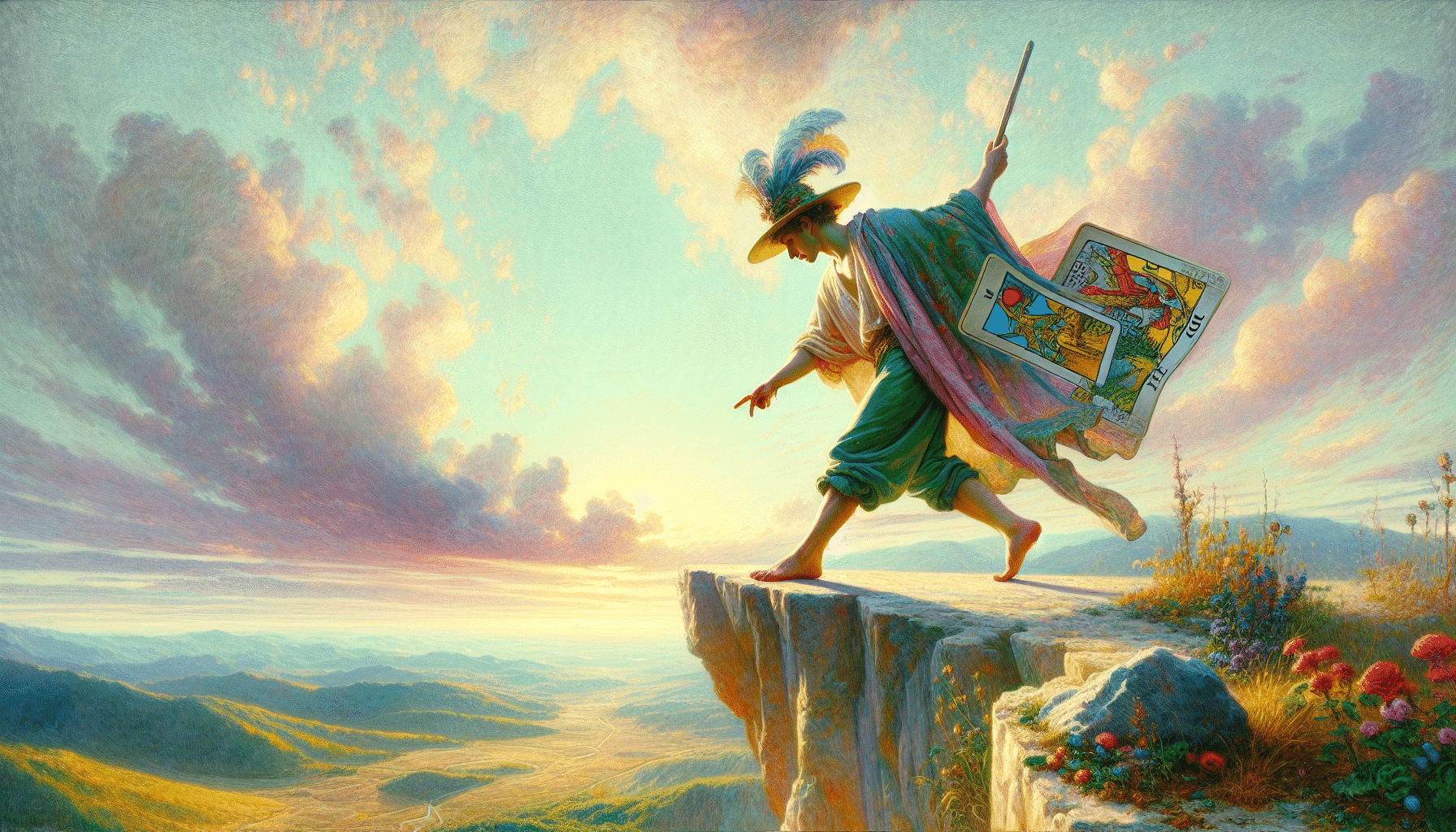
As you explore the rich tapestry of tarot card history, it’s clear that the humanist ideals of the Renaissance played a pivotal role in their evolution. During this period, the cultural emphasis on individualism and classical learning shaped the ways in which tarot imagery was conceived and interpreted.
The mystical elements inherent in tarot were intertwined with Renaissance humanism, which sought to reconcile the spiritual with the intellectual, elevating divination practices from mere fortune-telling to a more profound exploration of human experience.
Renaissance thinkers were fascinated by the idea of the microcosm and macrocosm, where the individual reflected the larger universe. This concept found its way into tarot, where each card could represent a universal aspect of human life. The human-centric worldview of the time encouraged a deeper contemplation of the cards, suggesting that they held not only predictive powers but also mirrored the moral and intellectual virtues celebrated by humanists.
Through this lens, tarot became a tool for self-reflection and personal growth, rather than an occult instrument. You can see this shift in the artwork and themes of the cards, which began to feature classical symbols and allegories that resonated with the humanist ethos.
The tarot’s evolution during the Renaissance reflects a broader cultural awakening to the potential within each individual, aligning mystical traditions with the era’s revolutionary ideas about human potential and self-awareness.
Impact of Printing Technology
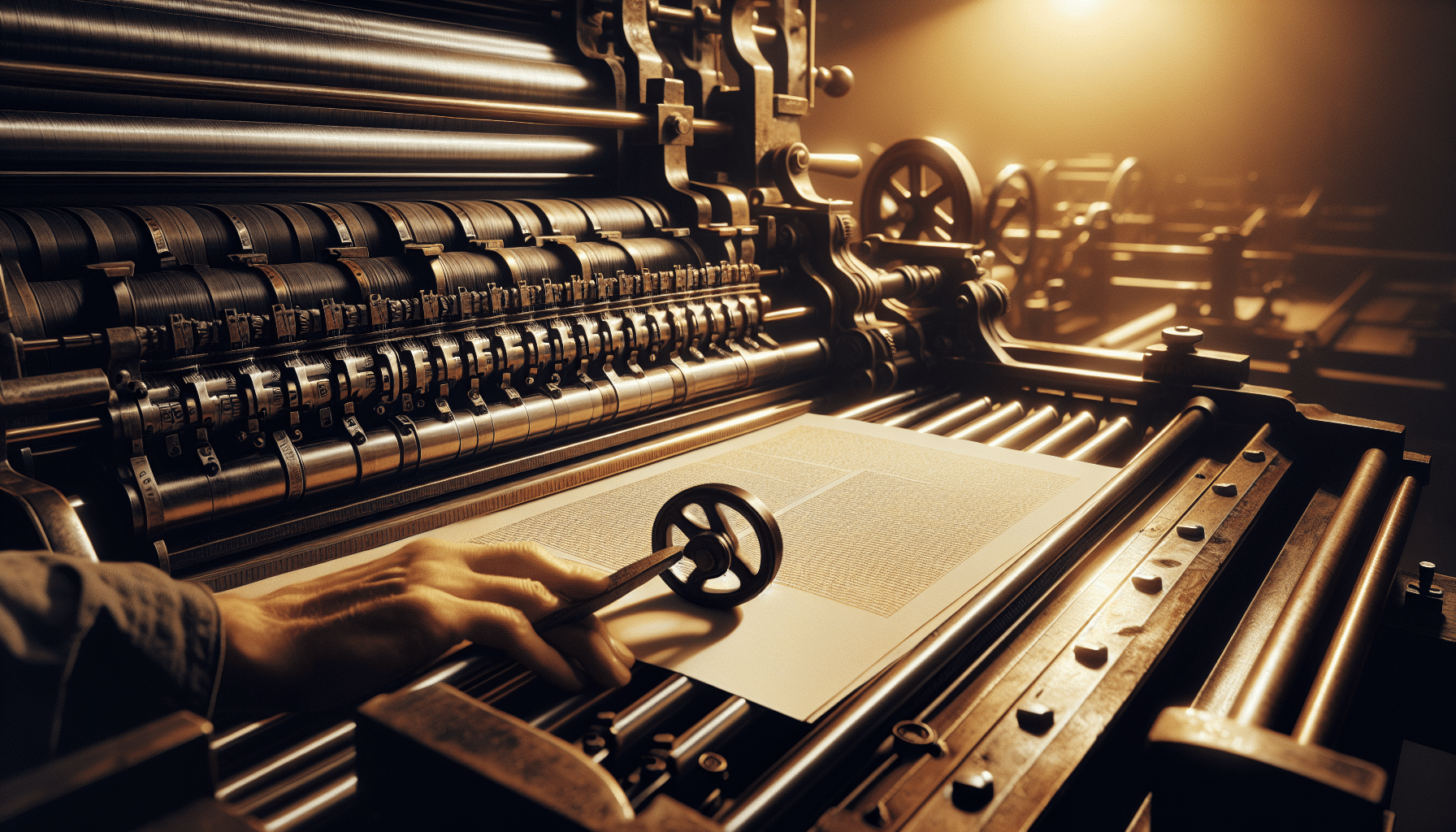
Recognizing the significant role of printing technology, you’ll find that it revolutionized the production and dissemination of tarot cards during the Renaissance. The printing press invention, attributed to Johannes Gutenberg in the mid-15th century, marked a pivotal turn in the way knowledge and imagery, including tarot cards, were spread across Europe.
The printing press made tarot cards more accessible via:
- Cost Reduction: Mass production slashed prices, making tarot decks affordable for a wider audience.
- Standardization: Consistent quality and design became possible, leading to uniformity in tarot cards.
- Increased Reach: With faster production, decks traveled beyond their birthplaces, influencing new regions and cultures.
Woodcut illustrations, a popular method for reproducing images before the advent of the printing press, found new life in this era. Printers embraced this technique to create intricate and symbolic imagery on tarot cards.
Advancements in woodcut techniques:
- Detail Enhancement: Printers refined woodcutting to include more elaborate details in tarot imagery.
- Reproducibility: Identical copies of the same card could be reproduced, ensuring a coherent visual language.
- Artistic Collaboration: Artists and printmakers often worked together, blending creative visions with technical skill.
As you delve deeper, you’ll appreciate how these innovations shaped the tarot, embedding Renaissance ideals into a deck of cards.
Geographic Spread of Tarot
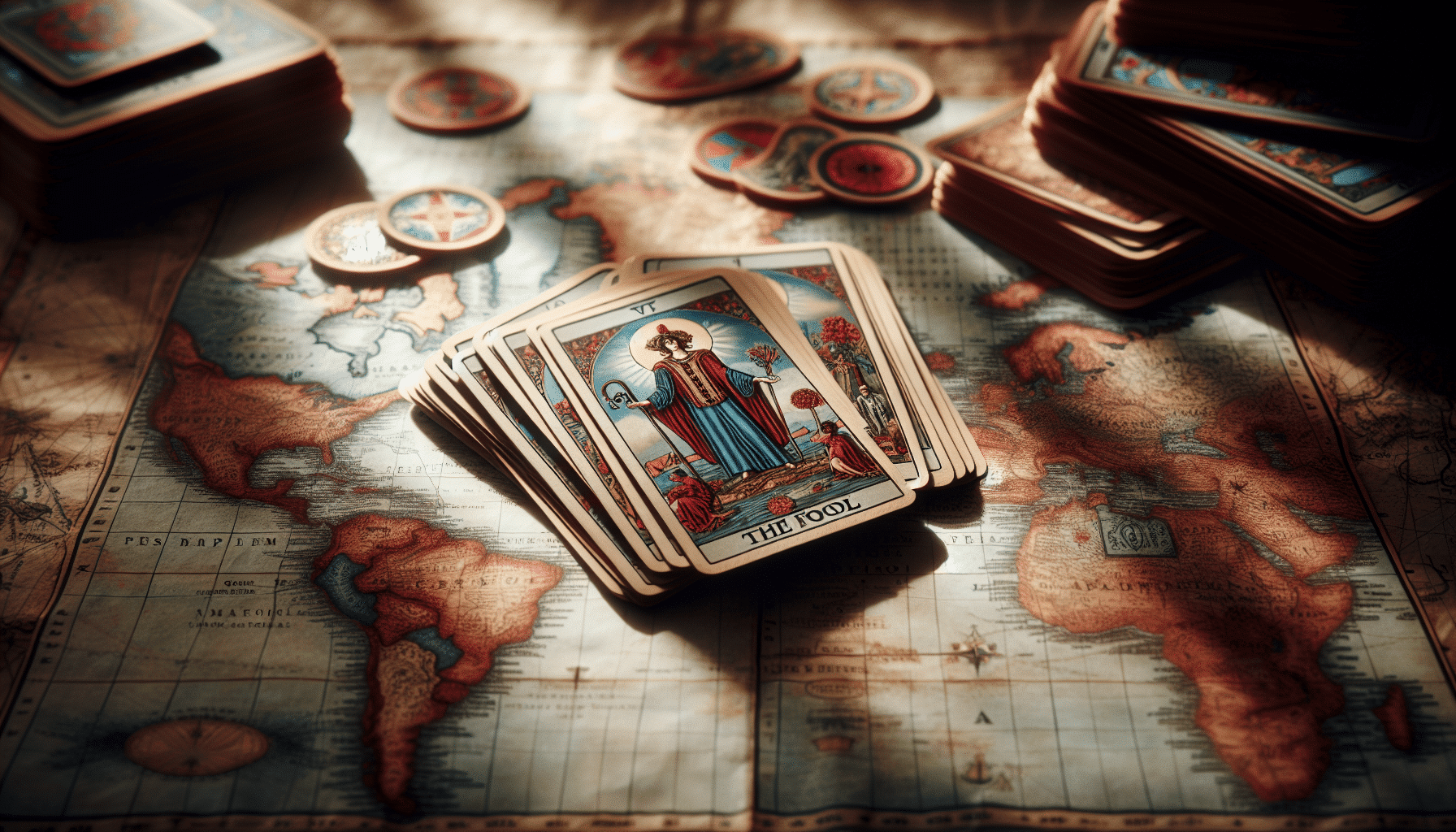
You’ll discover that the Renaissance era saw tarot cards proliferate across Europe, with at least five distinct regional styles emerging by the 16th century. It’s fascinating how these decks weren’t solely for divination; they were widely used for card games, weaving tarot mythologies into popular culture.
As you delve into tarot’s history, you’ll notice that each region stamped its own cultural mark on the cards, influencing the symbolism and artwork found in traditional decks.
Traveling merchants and the nobility carried tarot with them, catalyzing its spread from Italy to France, Switzerland, Germany, and beyond. In France, for example, tarot became known as ‘tarot de Marseille,’ a reference to the city that became a hub for card production. This style is still a standard for many modern tarot readers.
You’ll appreciate that understanding the geographic spread of tarot is essential to grasping its evolution. Each region’s interpretation of the tarot deck added layers to the mythologies and meanings associated with the cards, enriching the practice and the card games alike. As tarot’s popularity grew, so did the variety of its uses and the depth of its symbolism.
Transition to Occult Associations
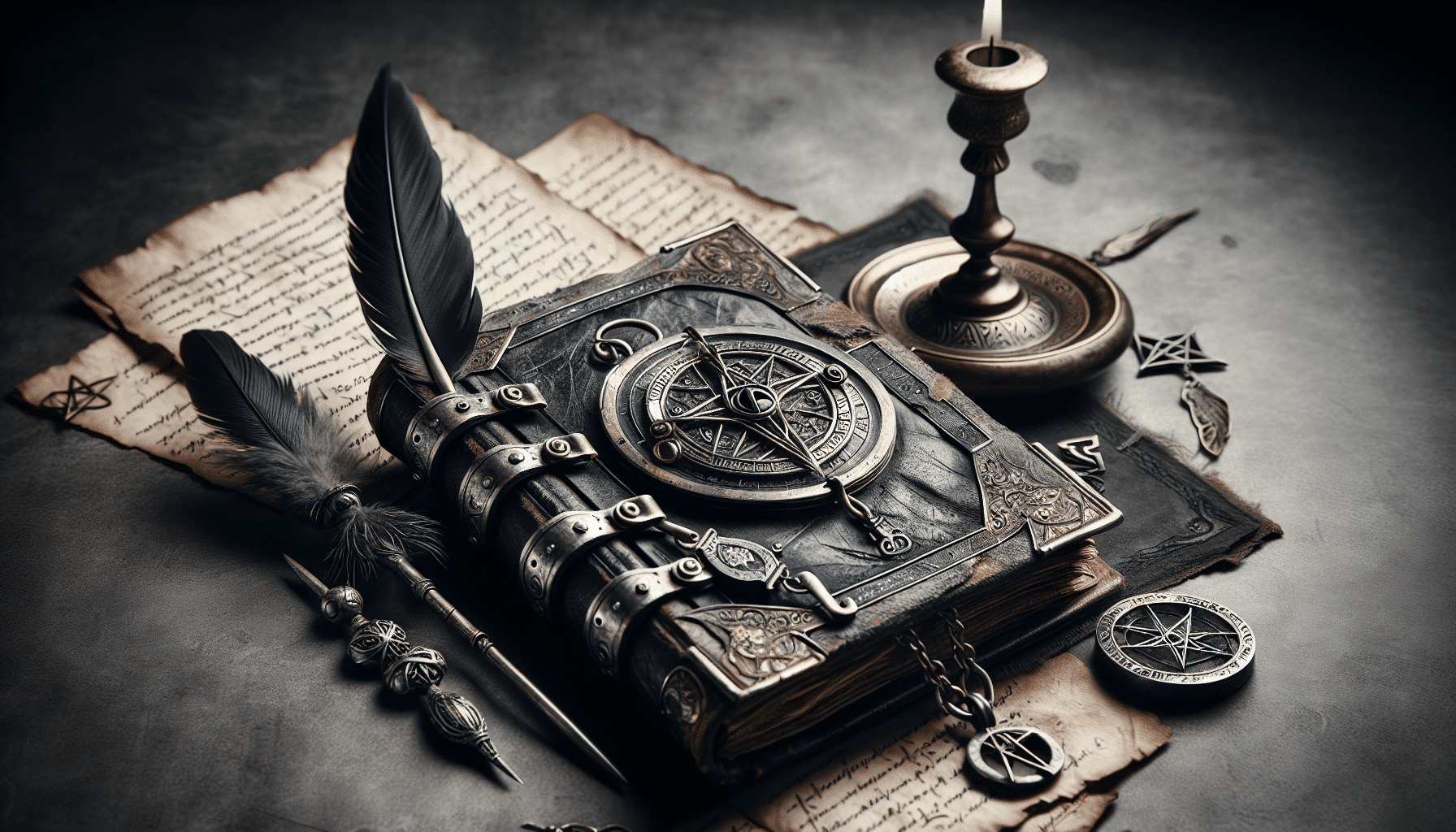
During the late Renaissance, you’ll notice that tarot cards began their shift from social pastimes to tools of the occult, reflecting deeper spiritual and esoteric meanings. This transition wasn’t abrupt; it unfolded as scholars and mystics delved into the mystic origins of these enigmatic cards.
Here are some important figures in Tarot’s integration into Occult practices:
- Antoine Court de Gébelin: A key figure who posited that tarot had ancient Egyptian roots.
- Éliphas Lévi: He linked the tarot imagery to the mystical Kabbalah, marrying the cards to Hebrew alphabet symbolism.
- The Hermetic Order of the Golden Dawn: This secret society further entrenched tarot’s role in divination methods and ritualistic magic.
As you explore this rich history, you’ll discover that the previously mundane tarot deck was transformed into a profound divinatory system. Each card became seen as a key to unlocking aspects of the subconscious mind and gaining insights into the spiritual realm.
The cards’ images, once just medieval archetypes, were reinterpreted through the lens of occult philosophies. The Fool, The Magician, The High Priestess, and others acquired new layers of symbolic meaning and purpose. It’s through this lens that tarot’s enduring legacy as a tool for divination and self-discovery was solidified.
Conclusion
As you’ve journeyed through the tapestry of tarot’s evolution, you’ve witnessed its transformation, deeply rooted in the Renaissance’s fertile cultural soil.
Consider this: by the 18th century, tarot decks were being produced by the thousands annually, a testament to their entrenchment in European society. This boom, catalyzed by the era’s innovations, mirrors your own potential for growth.
Let the rich symbolism of these cards inspire you to weave your own history with wisdom and creativity.

About The Author – Allen Hill
Allen Hill, the force behind Unknown Truth Tarot, has a YouTube following 6-times bigger than the population of his hometown, Miamisburg, Ohio. From his spiritually rich blog on Tarot and crystals to his role as CEO of The Unknown Truth Tarot Metaphysical Shop, Allen’s passion for the metaphysical shines through.
A master Tarot reader and “crystal junkie,” Allen is also a devoted dad to Dylan, 10, and Destiny, 24. When he’s not immersed in the world of Tarot and crystals, he enjoys poker and video gaming sessions, often humorously outplayed by Dylan.
Follow Allen on Twitter, Instagram, Facebook, TikTok, and subscribe to his Unknown Truth Tarot YouTube channel to join him on a journey of spiritual growth and self-discovery.

